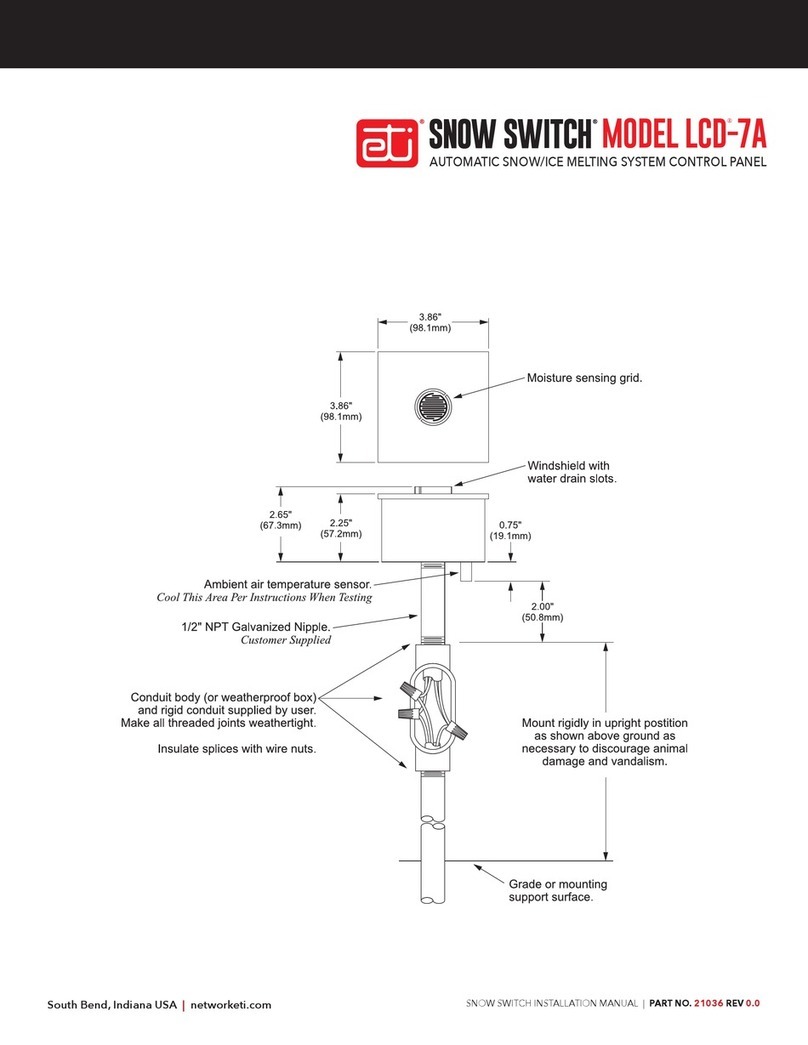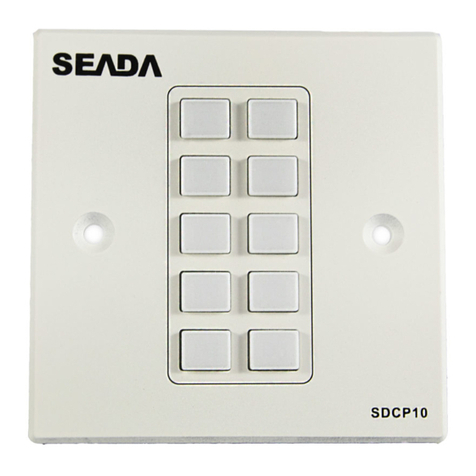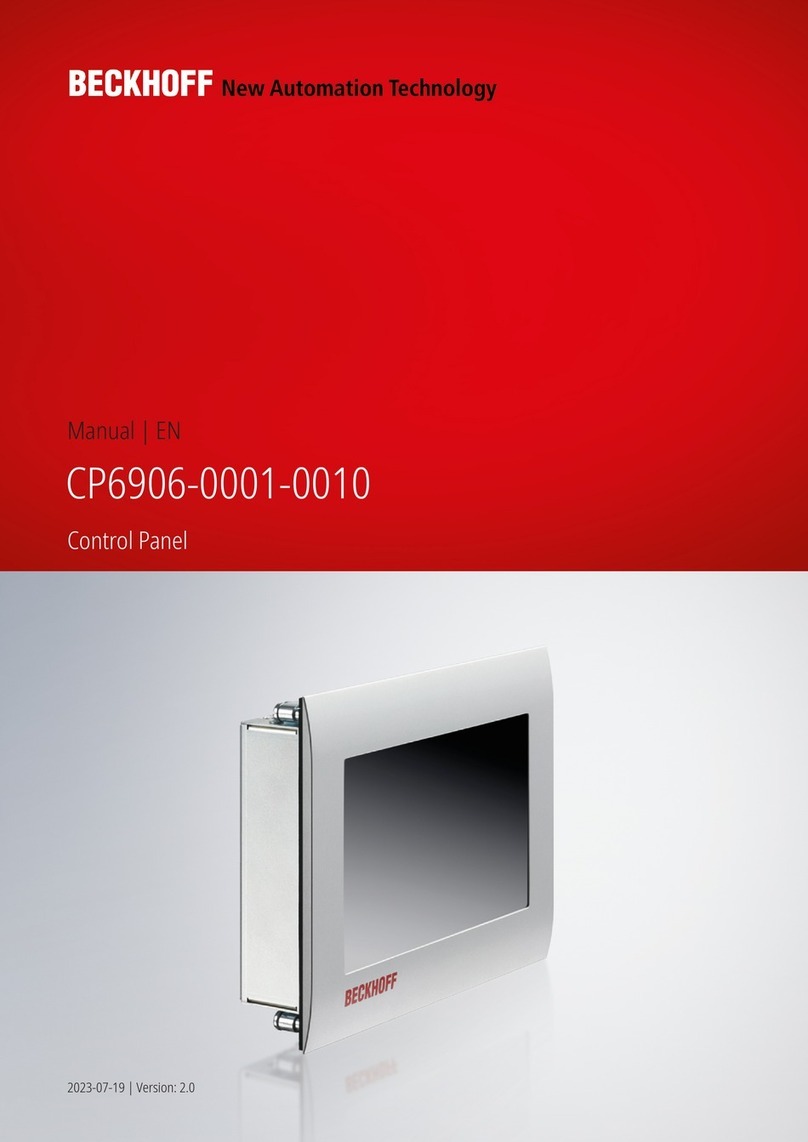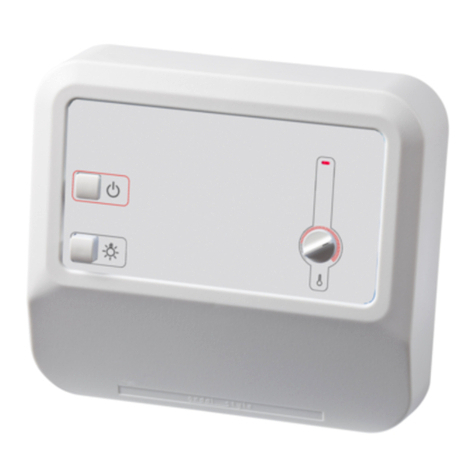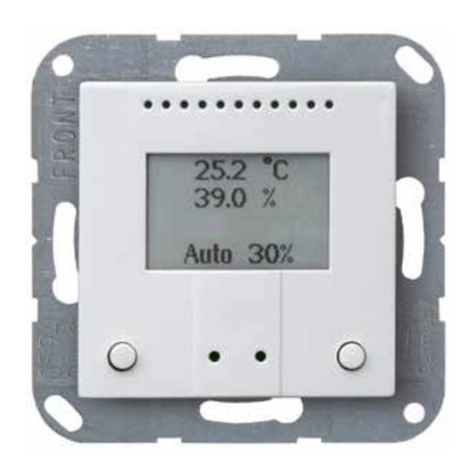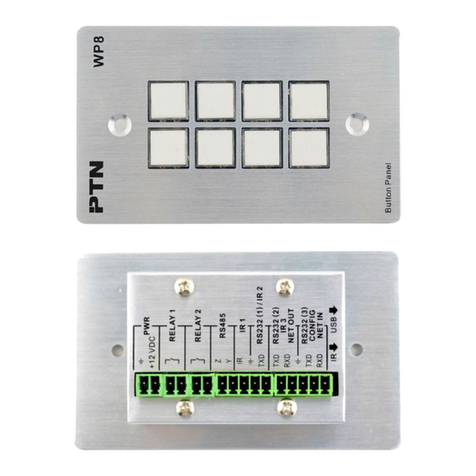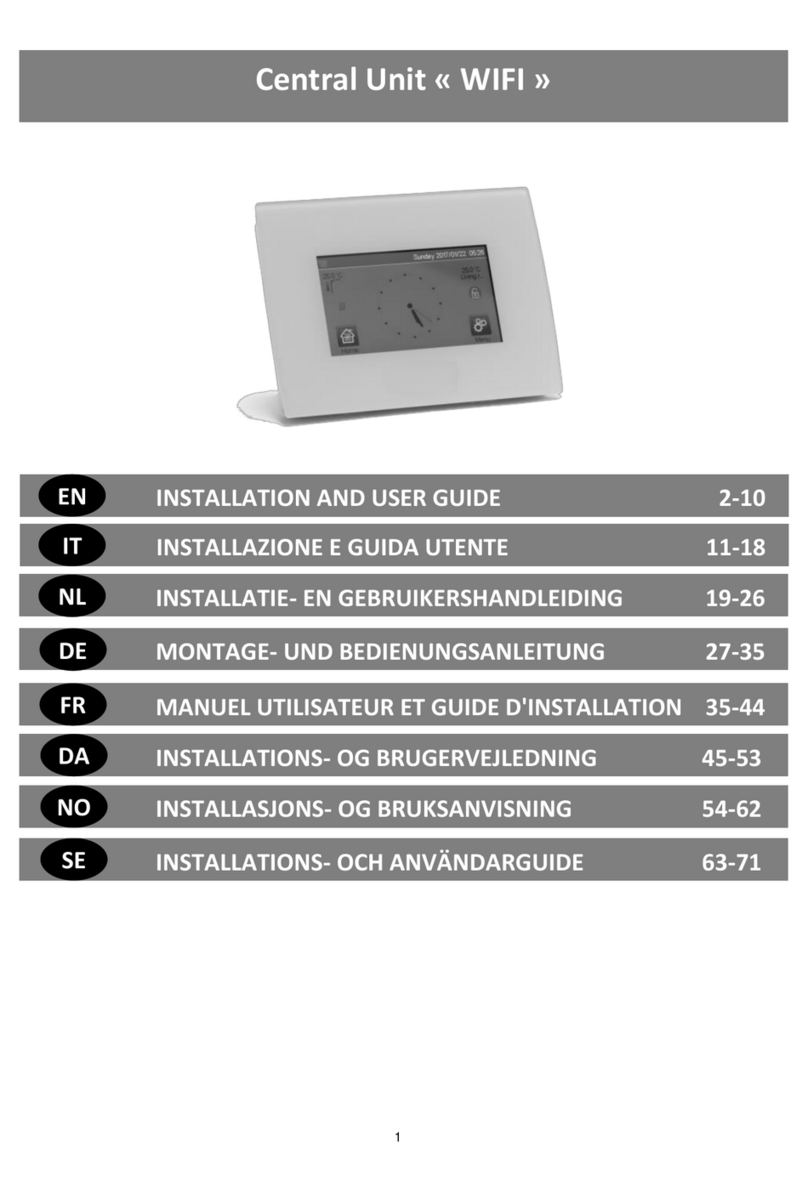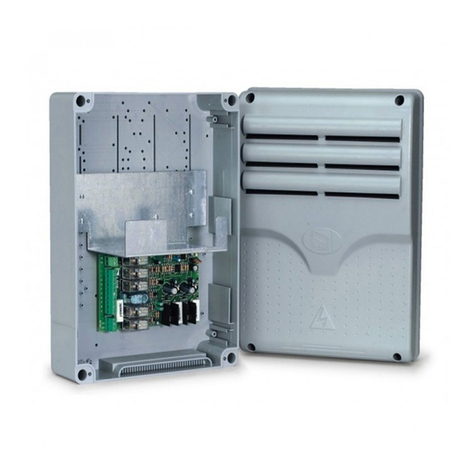Snow Switch GF PRO User manual

South Bend, Indiana USA | networketi.com SNOW/ICE CONTROL INSTALLATION MANUAL | PART NO. 23918 REV B
This manual refers to the Snow Switch® Model GF Pro control panel
manufactured since October 31, 2013, which uses a universal (100 –
277 VAC; 50/60 Hz) power supply. Older units use a voltage-specic
power supply and have different wiring congurations.
TABLE OF CONTENTS
Safety Information and Warnings................................................................3
Product Testing Record.................................................................................2
Unpacking the Unit........................................................................................3
Inventory.........................................................................................................4
Product Description ......................................................................................5
Selecting the Proper Sensor ........................................................................5
Available Optional Components.................................................................5
Installing the Control.....................................................................................6
Preparation and System Set-Up...................................................................8
System Schematic Diagrams........................................................................9
Post-Installation Testing ..............................................................................12
Operation .....................................................................................................14
Optional Remote Control Operation........................................................17
Maintenance.................................................................................................17
Troubleshooting ..........................................................................................18
Heater Connection ......................................................................................24
Specications ...............................................................................................25
Ordering Information..................................................................................26
MODEL GF PRO
AUTOMATIC SNOW/ICE MELTING SYSTEM CONTROL PANEL

South Bend, Indiana USA | networketi.com SNOW/ICE CONTROL INSTALLATION MANUAL | PART NO. 23918 REV B
2
SAFETY INFORMATION AND WARNINGS
Pilot Duty
The GF Pro snow and ice control cannot be used
for Pilot Duty applications.
Resistive Load Usage Only
This product is not for use with Inductive loads.
Inductive loads may create nuisance tripping of
the Ground Fault Protection Circuit.
Abnormal Odor or Smoke
In the event of smoke or a burning or abnormal
odor, immediately interrupt power to the unit by
turning off the circuit breaker protecting the unit.
Electrical Shock / Fire Hazard
Even when the heat tapes are disconnected, as
long as the circuit breaker is on and power is
running to the unit, voltage is still being applied
to the yellow heat tape leads. Therefore, never
touch the ends of the yellow leads or let the
two leads touch each other. Do not let the two
yellow heat tape leads contact any component
inside the unit.
Any installation involving electric heater wiring must
be grounded to earth to protect against shock and re
hazard. Suitable ground fault detection and interrupting
systems must be in use at all times to reduce shock and
re hazard and to protect equipment.
Electric wiring to heating elements must be installed
in accordance with National Electrical Code (NEC)
requirements, as well as all other local and applicable
electrical codes and any third party standards. Follow the
installation instructions contained in this manual and also
those provided by the heater manufacturer.
Size the circuit breaker in accordance with the size of the
expected load. The maximum current load for the GF
Pro is 30 Amp resistive. This product is intended for use
in residential or light commercial applications. For larger
or more critical installations, the “APS” Series of control
panels from ETI, provides a cost-effective solution offering
enhanced system design and performance features.
Make certain that the heater shield is properly grounded.
Failure to do so may result in damage to equipment or re.
Following installation and prior to beginning system
operation, refer to and perform the Post-Installation Tests
described in this manual.

South Bend, Indiana USA | networketi.com SNOW/ICE CONTROL INSTALLATION MANUAL | PART NO. 23918 REV B
3
PRODUCT TESTING RECORD
Use this page to record the results of the testing procedures in this manual. Specically, these are a
mega-ohm test following installation of the heat tape, a post-installation test of the control box, and
a post-installation test of the system sensor(s). This record will be a useful resource throughout the
life of the product.

South Bend, Indiana USA | networketi.com SNOW/ICE CONTROL INSTALLATION MANUAL | PART NO. 23918 REV B
4
UNPACKING THE UNIT
Immediately upon receipt, inspect the container and
packing material for any noticeable damage. Unpack the
unit, taking care not to damage the packing materials.
Save the shipping container and related materials until
normal operation has been established. If the unit must
be returned, take care to ensure that it is repackaged as it
was received.
As soon as the unit arrives at your facility, inspect it for
mechanical damage. If any of the following problems is
found, contact ETI, Customer Service immediately:
• contents incomplete or incorrect;
• internal or external mechanical damage; or
• defective operation.
ETI Customer Service is available between 8:00 a.m. and
5:00 p.m. Eastern Time. In the event of shipping damage,
keep the packing materials for inspection by the carrier.
RETURNS AND REPLACEMENT PART PURCHASES
Equipment cannot be returned for credit once it has
been installed. ETI will repair or replace faulty equipment
under warranty. Prior to removal of equipment for
warranty return, please contact ETI Technical Support for
troubleshooting assistance.
Before returning a unit to ETI, obtain a Return Merchandise
Authorization from our Customer Service Department,
available between 8:00 a.m. and 5:00 p.m. Eastern Time. If
possible, use the original container and packing materials
when packing the unit for shipment. It is important to
mark the Return Merchandise Authorization clearly
on the outside of the shipping container so that it may
be correctly processed upon receipt at Environmental
Technology. For more information about replacement
parts or for a replacement Data Sheet or Manual, please
visit www.networketi.com.
INVENTORY
Using the information below, verify that the shipping
packagecontainsallof thepartslisted.NotifyETI,Customer
Service immediately if there are any discrepancies. ETI
Customer Service is available between the hours of 8:00
a.m. and 5:00 p.m. Eastern Time.
Product # Description
1 GF Pro
PN: 23917
2 Accessory Kit
PN: 23731
3 GF Pro Installation Sheet
PN: 24454
4 GF Pro Intallation/Operation Manual
PN: 23918
Depending on the specics of your order, there will
also be up to two sensors included with the system, as
well. These will be either the CIT–1 aerial-mount sensor,
the GIT–1 gutter ice sensor, or the SIT–6E pavement-
mount sensor.
PRODUCT DESCRIPTION
The Snow Switch model GF Pro snow and ice control
with ground fault, when used with up to two compatible
sensors, automatically controls snow and ice melting
heaters for minimal energy costs. Applications include
pavement, sidewalk, loading dock, roof, gutter, and down
spout snow/ice melting in commercial and residential
environments. The GF Pro control can be powered from
an automatically selected operating voltage from 100
VAC up to 277 VAC and is rated for 30 amps resistive load.
An integral 30mA of GFEP provides additional safety and
compliance with national and local electrical codes.
The GF Pro control is housed in an environmentally-
sheltered IP 66, NEMA 4X weather-resistant enclosure to
provide several installation options.
Features and Benets
• Compatible with standard CIT–1, GIT–1, and SIT–6E

South Bend, Indiana USA | networketi.com SNOW/ICE CONTROL INSTALLATION MANUAL | PART NO. 23918 REV B
5
sensors
• Two sensor input to allow for application specic
sensor combination such as:
1. A CIT–1 aerial sensor and a GIT–1 gutter sensor
for roof and gutter deicing
2. A CIT–1 aerial sensor and SIT–6E pavement-
mounted sensor for snow melting
• Adjustable 0 – 8 hour hold-on time
• Integral 30 mA of GFEP with manual and automatic
test features
• Compatible with the RCU–4 remote control
• Durable IP66, NEMA 4X enclosure
• UL Listed to UL 873 Temperature-Indicating and
-Regulating Equipment
• UL Listed to UL 1053 Ground-Fault Sensing and
Relaying Equipment
SELECTING THE PROPER SENSOR
The Snow Switch model GF Pro snow and ice control
is designed for use with up to two compatible sensors.
Compatible sensors include the CIT–1, GIT–1, and SIT–
6E snow and ice melting sensors. These sensors have
provided the industry’s most versatile and cost effective
snow melting control when used with Environmental
Technology control panels. Sensors should be selected
to best suit the intended application.
The CIT–1, GIT–1, and SIT–6E snow and ice melting
sensors combine to reliably detect snow and ice in gutter
and pavement applications. The CIT–1 sensor may be
paired with either the GIT–1 sensor for gutter applications
or the SIT–6E sensor for pavement applications. These
sensors detect precipitation as snow at temperatures
below 38°F (3.3°C). Control panels are signaled only if
moisture occurs below this temperature, saving energy
and ensuring reliable melting.
(Table 1) presents the recommended sensor combinations
for use
with the GF Pro snow and ice control.
One or two CIT–1 Sensors
One GIT–1 Sensor
One GIT–1 and one CIT–1 Sensor
One SIT–6E Sensor and one CIT–1 Sensor
For more complete information regarding the sensors
and their individual capabilities, refer to the Products link
on the ETI website, www.networketi.com.
AVAILABLE OPTIONAL COMPONENTS
Prior to installation and set-up, it is rst useful to discuss
two important optional components available for the
Snow Switch GF Pro system. The rst of these optional
components is a Remote Control Unit, RCU–4 (Part
Number 21358), which allows remote operation of the
system away from the control box. The second optional
component is a Temperature Sensor Assembly (Part
Number 19272) which regulates the heating cycle to make
it more efcient. Neither of these optional components
comes with the basic system so either or both of them
must be ordered separately and installed along with the
system, not only to facilitate their installation but also to
optimize their performance.
With the Remote Control Unit, RCU–4, the operator is able
to access the full range of system functions and controls
from a second location. With the RCU–4, the operator can
manually set the Cycle Time, equivalent to the Hold-On
Time setting on the face of the unit itself; manually initiate
or terminate a heating cycle; and test and reset the GFCI
circuitry. The capability for remote operation is especially
useful if the control box is installed either outside or in
TABLE 1. Recommended Sensor Combinations

South Bend, Indiana USA | networketi.com SNOW/ICE CONTROL INSTALLATION MANUAL | PART NO. 23918 REV B
6
a location of the building not easily or readily accessible
by ofce personnel who may well be in a better location
than building maintenance personnel to assess the need
to melt ice or snow from walkways or parking areas.
Also available for the GF Pro system is an optional
temperature sensor assembly which senses the
temperature at the cable end and regulates the Hold-On
Time period once precipitation has ended and the call
for heat has passed. Installed with the cable end placed
at or near the heat tape, the optional temperature sensor
assembly or thermistor is a high-temperature shut-off
and regulates the Hold-On Time period by automatically
suspending an active heating cycle if at any time during
that cycle, the temperature at the sensor end rises to
above 45°F. Then, if, during the Hold-On Time period, the
temperature drops to below 44°F, the heating cycle will
resume automatically and continue until the end of the
Hold-On Time period as set on the face of the unit. This
not only lowers system operating costs but also protects
the heat tape from over-heating.
As the placement of the RCU–4 remote control unit
is a key factor in the overall conguration of, as well
as customer satisfaction with, the GF Pro system, it is
important that it be installed as part of the system initially.
Similarly, as the temperature sensor assembly monitors
the temperature at the point of the cable end to keep the
heat tape from over-heating, so it is necessary, for best
results, to lay the temperature sensor at the same time as
the heat tape to ensure proper placement and routing.
It is not recommended to try and retrot either of these
optional assemblies once the system is already installed
and operational.
To ensure proper installation and to facilitate placement,
wiring, routing, and function of either or both the optional
RCU–4 or temperature sensor, it is strongly advised and
suggested that these assemblies, whether together or
individually, be installed with the system initially rather than
retrotted afterwards. Use the information below to order
either or both of these important optional components.
Order # Description
21358 Optional Remote Control Unit RCU–4
19272 Optional Temperature Sensor Assembly
To order either or both of these optional components for
your system, contact the ETI Sales Department between
the hours of 8:00 a.m. and 5:00 p.m. Eastern Time.
INSTALLING THE CONTROL
Install this unit in compliance with National Electrical Code
(NEC) standards, as well as all other local and applicable
electricalcodesforyourarea.Priortobeginninginstallation,
make sure that the facility has properly sized electric
service and breaker. For additional information regarding
electrical ratings and facility power requirements, refer to
the Specications section of this manual.
This unit is intended for wall mount installation only.
The wall used for the installation should be capable of
supporting four times the weight of the unit, or about 20
pounds. Although the IP 66, NEMA 4X weather-resistant
enclosure can be installed outside, make sure to install the
unit directly to a solid, stable surface. Before connecting
any optional remote control unit or system sensor(s),
as applicable, to the terminal block inside the unit, rst
install the box itself. Internal connections for any optional
remote control unit or system sensor(s) will be made in
the next section.
During installation, leave all mounting hardware loose enough to allow for slight adjustments to component
placement. Once all components and the front panel and clear plastic cover have been installed, then, as
the nal step in installation, fully tighten all mounting hardware and weather-tight ttings. Make sure all
connections and ttings are snug, air-tight, and water-tight.
NOTE:

South Bend, Indiana USA | networketi.com SNOW/ICE CONTROL INSTALLATION MANUAL | PART NO. 23918 REV B
7
The dimensions shown in the Top View of Figure 1 below are for the mounting hole location footprint
and run from centerline to centerline of the four slotted mounting holes. The dimension shown in the
Right Side View of Figure 1 is from the bottom of the enclosure to the top of the clear plastic lid and
shows the distance that the unit will protrude from the mounting surface.
FIGURE 1. GF PRO Mounting Hole Footprint
To install the control box, perform the steps below.
1. Use the box as a template to determine the mounting
hole footprint pattern. Hold the unit up against the
wall onto which it will be mounted, with the mounting
blocks against the wall, then mark the wall at the
locations of the slotted mounting holes to determine
the location of the mounting holes on the wall.
2. As desired, to hold the box in place during the
installation process, you may loosely install one or
both of the top mounting bolts as the remaining holes
are marked. To ensure accurate and level installation,
however, do not fully tighten any of the mounting
hardware until the locations for all the mounting holes
have been determined and marked.
3. Once the four mounting holes have been located and
marked, install the box to the wall using properly sized
mountinghardware.Besuretouse mounting hardware
appropriate for the job, heavy-duty and long enough
to fasten the unit securely to the mounting surface.
Make sure to use all four mounting holes. Because
conduit will also be installed to protect the cables
running from the control box, install the box, but leave
the mounting hardware loose enough to work the
conduit into place. The conduit will be installed later
in this process, at which time all mounting hardware
will be securely tightened.

South Bend, Indiana USA | networketi.com SNOW/ICE CONTROL INSTALLATION MANUAL | PART NO. 23918 REV B
8
PREPARATION AND SYSTEM SET-UP
Install the conduit, system sensor(s) and cables, heater
cables, and power cable. Refer to Figures 2 and 3, as
well as Table 2. Remove the clear plastic unit cover and
face plate to access the inside of the unit. These will be
replaced at the end of the installation process. A post-
installation test will be performed in the next section to
verify proper function.
Installing the Conduit
Only UL listed, Type 4X,raintight conduit hubs and cable
glands are to be used. The hub is to be connected to
the conduit of a rigid conduit system before the hub is
connectedtotheenclosure.Select,measure,cut,andinstall
the conduit in accordance with all National Electrical Code
(NEC) requirements, all local and applicable building and
electrical codes, as well as the manufacturer’s instructions.
Ensure a sealed, watertight installation.
Installing the Sensor(s)
Refer to the enclosed Installation Sheet(s) and Instruction
Manual(s)forsensorinstallationandoperatinginstructions.
Installing the Sensor Cables
Route the sensor cables through the weather-tight
connection ports on the right side of the unit, as shown
in Figure 2, then connect the red, black, and white leads
to the front panel PC board terminal block J1 terminals.
If using two sensors in the system, even if they are of the
same type, it does not matter which one is wired into which
set of terminal blocks, upper or lower. After connecting
the red, black, and white leads, push a little more of the
cable into the connection port to create a little more
slack to relieve some of the tension from the wires at the
point of the terminal strip, then fully tighten the weather-
tight connection to secure the cable in place. If installing
an extension onto the sensor cable(s), a junction box is
required in accordance with applicable code.
Installing the Heater Cables
Lay-out, congure, and install the system heater cables
in accordance with National Electrical Code (NEC) and
manufacturers’ requirements, as well as all other local and
applicable building and electrical codes. Make sure to
properly seal and waterproof all cable runs. If using a SIT–
6E pavement-mount sensor, position the heater cabling
so it does not interfere with the sensor wiring.
Upon conclusion of heater cable installation, perform
a mega-ohm or “megger” test on the heater cables as
directed by the heater cable manufacturer. Record the
results on page 2 of this manual and retain for future
reference.
Installing the Optional Components
Route the remote control (RCU–4) cables through the
conduit then into the enclosure. Connect the remote
cables to the front panel PC board terminal block J1
terminals labeled REMOTE.
Route the optional temperature sensor assembly wiring
through the same conduit as the RCU–4 cable then into
the enclosure. Connect the temperature sensor assembly
cables to the front panel PC board terminal block J1
terminals labeled AUX.
Installing the Power Cable
With the circuit breaker off, install the power cable. As
shown in the wiring charts, the power cable is provided
by the customer. Size the cable for a 30 Amp maximum
load. Run the cable through conduit and connect the
leads to the control box wiring. The line is black, neutral is
white, and ground is green. The unit has no power switch
so remember that power is running to the system as soon
as power is applied.

South Bend, Indiana USA | networketi.com SNOW/ICE CONTROL INSTALLATION MANUAL | PART NO. 23918 REV B
9
SYSTEM SCHEMATIC DIAGRAMS
Figure 2 is a schematic diagram of an entire GF Pro system,
including the available optional components.
TABLE 2. Cable Ratings and Connections
FIGURE 2. Representative GF PRO System Schematic

South Bend, Indiana USA | networketi.com SNOW/ICE CONTROL INSTALLATION MANUAL | PART NO. 23918 REV B
10
A representative schematic diagram of an SIT–6E pavement sensor installation is shown
below in Figure 3. Note how the heat tape and other components do not cross.
FIGURE 3. Representative SIT–6E Pavement Installation

South Bend, Indiana USA | networketi.com SNOW/ICE CONTROL INSTALLATION MANUAL | PART NO. 23918 REV B
11
FIGURE 4. The GF PRO Front Panel PC Board
Refer to Figure 4 for useful information regarding the front panel PC board.

South Bend, Indiana USA | networketi.com SNOW/ICE CONTROL INSTALLATION MANUAL | PART NO. 23918 REV B
12
POST-INSTALLATION TESTING
Installation errors cause the majority of system problems.
Therefore, thoroughly check the system before placing it
into service. Simple electrical tests and visual inspection
can identify any wiring errors, as well as improper
waterproong. Visually inspect for proper wiring and
waterproong, making sure that all box joints are sealed
and that all wiring is properly terminated.
In performing the post-installation test procedure as
described below, the heat tape will activate, even if
only for a brief time, so that system performance can be
accurately simulated and measured. For that reason, and
depending specically on the ambient temperature or
general conditions in which the system is being installed,
it is recommended to continuously and carefully monitor
the system and its components during the entire testing
process. High temperatures can cause damage to asphalt
and similar paving materials. Never leave the site during
testing. Never leave the system unattended during
testing. If re or smoke or an abnormal odor is observed
during testing, shut off power to the system and suspend
the test.
To most accurately simulate and measure system
performance, leave the heat tape connected to the
control during testing and use a clamp-on amp meter
as directed in this procedure. Using the clamp-on amp
meter clamped around the wires prevents the operator
from having to touch bare or exposed metal or wiring and
also keeps the operator from having to break the circuit,
all while still allowing the accurate simulation and testing
of the system, including the Ground Fault Equipment
Protection circuitry, if your system is so equipped.
It is the responsibility of the on-site installer to assess
the overall safety concerns at the site and to disconnect
the heat tape, as necessary or desired, whether before
or during this test, as well as to re-establish those wiring
connections at the conclusion of this procedure.
This procedure requires a clamp-on amp meter or
voltmeter. Make sure the gutter and downspout are both
dry before testing the GIT–1 sensor. Record test results
in the appropriate section on page 2 of this manual for
future reference.
CONTROL TESTING
1. Remove system power. There may be two or more
points of disconnect.
2. Open the clear plastic cover and remove faceplate
from the unit. Retain all parts and mounting hardware.
If the heaters have been disconnected for testing,
using a voltmeter, measure the voltage across the two
yellow leads. If the heaters have not been removed
tor testing, using a clamp-on amp meter, measure the
current through the yellow lead.
3. Restore power to the unit. After a brief initialization
routine, the SUPPLY LED should be on, but no other
LEDs. Once initialization is complete, the amp meter
should read 0.
4. With power still running to the unit, turn up the Hold-
On Time dial to a setting higher than 0, then press the
Heater Cycle button. The HEAT LED should come on
and the amp meter should show a reading of less than
the maximum system load as shown on the faceplate.
The voltage across the yellow leads will match the
system voltage. Do not touch the yellow lead ends.
5. Press the Heater Cycle button again. The HEAT LED
will go off and the amp meter reading should drop
back to 0 or the voltage will drop to 0.
Even when the heat tapes are disconnected, as
long as the circuit breaker is on and power is
running to the unit, voltage is still being applied
to the yellow heat tape leads. Therefore, never
touch the ends of the yellow leads or let the
two leads touch each other. Do not let the two
yellow heat tape leads contact any component
inside the unit.
WARNING

South Bend, Indiana USA | networketi.com SNOW/ICE CONTROL INSTALLATION MANUAL | PART NO. 23918 REV B
13
6. Now, press the GFEP Test/Reset button on the unit
face plate. The GFEP LED should ash, during which
time you should hearing some clicking sounds
from the relays inside the unit, and the amp meter
reading should again read 0 after the GFEP self-test
is complete. Record results on page 3 of this manual.
Remove the amp meter or voltmeter. Do not yet re-
install the unit front plastic cover or face plate.
7. Proceed to sensor testing below.
CIT–1 AND GIT–1 SENSOR TESTING
The CIT–1 and GIT–1 sensors have two interrelated
systems: the temperature sensing system and the moisture
detection system. Complete testing of the sensor involves
manipulation of both. The tools needed for this procedure
are a voltmeter and an aerosol circuit cooler (“Freeze
Spray” is preferred) or cup of ice water. The Freeze Spray
is available at most electric supply stores.
Ensure that the moisture sensing grid on the sensor is
clean and dry.
Follow the steps below to perform the CIT–1 and GIT–1
sensor post-installation test procedure. The SIT–6E testing
procedure is on the next page.
1. Connect the voltmeter across the black and red leads
from the sensor (low-voltage wiring terminals at the
control). Connect the black test lead to the black wire.
You should obtain a reading of 23 to 28 VDC. Now,
check the reading across the black and white sensor
leads. You should read 22 to 28 VDC with a warm
(above 38°F) and dry sensor. Both the SNOW LED and
HEAT LED should remain off.
2. Cool the temperature probe of the sensor with
the Freeze Spray. You should see frost form on the
temperature probe.Alternately, place the temperature
probe in ice water. The SNOW LED and HEAT LED
should remain off.
3. Using a moist nger, touch the moisture sensing grid
on top of the sensor. Both the SNOW LED and HEAT
LED should come on and the voltage between the white
and black sensor leads should be less than 2 VDC.
4. With the unit cold and the sensing grid moist, allow
the unit to warm up to above 38°F. The SNOW LED
should turn off and the HEAT LED should stay on and
the voltage should return to 22 to 28 VDC. Record
results on page 2 of this manual.
5. If testing a SIT–6E sensor, proceed to the next section
now. If testing is complete, with unit powered off,
restore all wiring connections and re- install the face
plate and clear plastic cover. Set the Hold-On Time
control dial to the desired setting.
SIT–6E SENSOR TESTING
If paving material or other residue adheres to the sensing
elements, clean the surface with a Scotch™ Brite Pad.
Avoid using metallic or coarse abrasives or detergents.
Regardless of weather conditions,the functional operation
of an installed SIT–6E sensor can be determined using a
digital voltmeter (DVM) and a 10-pound (4.54kg) bag of
crushed ice as described below.
1. With the DVM set to the 100 VDC range, verify the
sensor supply voltage by connecting the negative
(–) test lead to the sensor black wire and the positive
(+) test lead to the sensor red wire. A DVM reading
between 23 and 28 VDC is acceptable.
2. With the negative (–) test lead remaining in place,
reconnect the positive (+) test lead to the sensor white
wire and conrm there is 22 to 28 VDC present. Both
the HEAT LED and the SNOW LED should be off.
3. Place the entire contents of the bag of crushed
ice on top of the sensor and allow a time lapse in
excess of 20 minutes before observing that less
than 2 VDC is indicated by the DVM. Depending on
ambient conditions, however, this might take only a
few minutes, in which case, that is not a problem. (A
nominal temperature below 38°F or 3.3°C must be
detected before the sensor’s normally-open contact
is closed. If the sensor surface temperature was
excessive prior to beginning this procedure, it will be
necessary to extend the cool-down time interval by as
much as an additional 20 minutes.) Most importantly,
make sure both the HEAT LED and the SNOW LED
come on. Record results on page 2 of this manual.

South Bend, Indiana USA | networketi.com SNOW/ICE CONTROL INSTALLATION MANUAL | PART NO. 23918 REV B
14
4. With satisfactory results, control and sensor pre-
operational testing is now complete. Disconnect and
remove all testing devices from the system.
5. Once all post-installation testing is complete and with
unit power off, restore all wiring connections.
6. Re-install the face plate and clear plastic cover onto
the control. Set the Hold-On Time control dial to the
desired setting.
OPERATION
This section presents operating instructions for the unit
and begins with a picture of the front panel. Refer to
Figure 5. Note the system information on the left side of
the panel, as well as the operator controls and indicators
located on the right side of the panel. The controls and
indicators are explained in this section.
Note that because the unit has no ON/OFF power
switch, power runs to the unit as soon as facility power
is connected to it. For as long as power is running to the
unit, the green SUPPLY LED will always be lit. The unit
initiates a heating cycle when the system sensor(s) detect
snow or ice at or below 38°F (3.3°C).
Upon initial Start-Up, all of the LEDs will come on for 2.5
seconds, and then shut off for 2.5 seconds. Following
this, the unit performs a ground fault self-test which lasts
about two seconds, during which the GFEP LED will blink
rapidly, about 8 times per second. During this phase of
the test, the yellow heat tape leads are live. After this, the
device goes into normal operation.
FIGURE 5. The GF PRO Front Panel
NOTE: Cover screws maximum torque: 4 In-Lbs.

South Bend, Indiana USA | networketi.com SNOW/ICE CONTROL INSTALLATION MANUAL | PART NO. 23918 REV B
15
FIGURE 6. The GF PRO Operator Controls and Indicators
SUPPLY The SUPPLY LED lights up and stays lit as long as power is running to the unit,
whether it is currently in a heating cycle or not.
HEAT When the HEAT LED is lit, the unit is currently engaging power to the heater
outputs in response to sensor input. The HEAT LED stays on for the duration of
the heating cycle. As desired, press the Heater Cycle button to stop a current
heating cycle, unless the SNOW LED is lit.
SNOW The SNOW LED lights up when any of the sensors detect snow or ice at or below
38°F (3.3°C) and stays on until the sensors no longer detect snow or ice or the
temperature surpasses 38°F (3.3°C). Note that the Heater Cycle button cannot be
used to cancel a current heating cycle if the SNOW LED is lit.
GFEP If solid, the GFEP LED indicates the presence of a Ground Fault. Press the GFEP
TEST/RESET button to try and clear the situation. If blinking, that indicates that a
ground fault test is currently in progress and it will autom
Operator controls and indicators are explained below. Refer to Figure 6

South Bend, Indiana USA | networketi.com SNOW/ICE CONTROL INSTALLATION MANUAL | PART NO. 23918 REV B
16
SETTING THE HOLD-ON TIME
Heating action begins a few seconds after the system
sensor(s) detect moisture at or below 38°F (3.3°C).
However, heating action continues even after the sensor
no longer detects moisture based on the Hold-On Time
setting. The Hold-On Time control knob allows you to set
the length of time the unit will continue heating even after
the sensor(s) no longer detect moisture. This is benecial
because it typically takes longer for ice to melt than it took
to form initially and also because it keeps moisture from
re-freezing before it has fully melted. As indicated on the
front panel, the Hold-On Time can be set for anywhere
from 0 to 8 hours as indicated by the arrow on the control
knob. Note that if the Hold-On Time control knob is set at
0 (as shown in Figure 6), the system will produce heat only
for as long as the sensor(s) detect moisture but no longer.
For that reason, and to ensure more effective heating, it is
recommended that the Hold-On Time be set up closer to
the mid-way point, corresponding to about 2 to 6 hours.
Set or increase the Hold-On Time as desired by rotating
the control knob to the right or clockwise. Decrease the
Hold-On Time setting by rotating the control knob to the
left or counterclockwise. Again, remember that if the Hold-
On Time control knob is set at 0, the unit will produce heat
only for as long as the system sensor(s) detect moisture
and no longer.
USING THE HEATER CYCLE BUTTON
The Heater Cycle control button allows you to manually
initiate a heating cycle regardless of weather conditions,
whether or not the sensor currently detects moisture, and
regardless of the temperature. The Heater Cycle control
button also allows the operator to cancel a heating
cycle currently in progress, regardless of the Hold-On
Time setting, unless the SNOW LED is on, indicating
the sensor(s) currently detect moisture at or below 38°F
(3.3°C). Remember, if you manually initiate a heating
cycle by pressing the Heater Cycle button, that heating
cycle will last for the duration of the current Hold-On Time
setting, unless manually cancelled by pressing the Heater
Cycle button a second time.
It is not necessary for the Hold-On Time setting on the
control box and the Hold-On Time setting on the RCU
to be identical. Note, however, that if a heating cycle is
manually started by pressing the Heater Cycle button on
the control box, that the resulting heating cycle will last
as long as the Hold-On Time setting on the control box.
Similarly, if a heating cycle is initiated using the RCU, the
resulting heating cycle will last as long as the Hold-On
Time setting on the RCU.
USING THE GFEP TEST/RESET BUTTON
GFEP (Ground Fault Equipment Protection) circuitry is
present inside this unit. The system software checks for
ground fault conditions continuously at set intervals. If the
GFEP LED is lit, press the GFEP Test/Reset button to try
and clear the situation and reset the ground fault circuitry.
The GFEP will perform a test of the ground fault circuitry,
during which time, the GFEP LED will blink. Pressing the
button will not clear a “hard” fault. When the GFEP LED
is lit, the heaters are turned off and will remain off until
the condition is cleared. When the GFEP LED is not lit,
the operator may press the GFEP Test/Reset button, as
desired, to manually initiate a test of the GFEP circuitry.
During the test, the GFEP LED will ash rapidly for a few
seconds while the circuitry rst tests the inside of the unit,
then the system heater coils, and will then shut off.
In the event of a ground fault condition that is not cleared
by pressing the GFEP Test/Reset Button, perform the
steps below.
1. If the GFEP LED on the control box is still lit after
pressing the GFEP Test/Reset Button, remove power
from the unit using the service disconnect or the
circuit breaker.
2. Perform a “megger” test of the heater cables and compare
the results to those obtained during Post-Installation
Testing and recorded on page 2 of this manual.
3. Locate and x the problem, typically found along the
run of the heat tape.
4. Restore system power. Because the presence of a
ground fault condition is stored in memory, even after
repairing the ground fault condition, the GFEP LED
might still be lit following restoration of system power.
In this case, press the GFEP Test/Reset button again
and the LED should go out and normal operations
may resume.

South Bend, Indiana USA | networketi.com SNOW/ICE CONTROL INSTALLATION MANUAL | PART NO. 23918 REV B
17
OPTIONAL REMOTE CONTROL OPERATION
The GF Pro can be operated either “locally” on the face
of the unit itself or by using the optional Remote Control
Unit, RCU–4. Refer to Figure 7.
The RCU Cycle Time control dial moves in discrete
increments rather than in a continuous motion as on the
control box. Cycle Time on the RCU applies only to a
manual heating cycle initiated at the RCU, not the Cycle
Time setting on the control box. The RCU cannot be used
to manually cancel a heating cycle which was manually set
on the control box.
To manually start a heating cycle using the RCU, press
the RCU Heater Cycle control button. The RCU HEAT LED
light will come on. This will start a heating cycle which will
last as long as the RCU Cycle Time setting.
To manually cancel a current heating cycle which was
manually set at the RCU, press the RCU Heater Cycle
button. The RCU HEAT LED light will go out.
To use the RCU to change the duration of a heating
cycle that was manually set on the RCU, turn the RCU
CYCLE TIME control dial to the desired setting, either
higher or lower.
If a ground fault condition occurs, the RCU HEAT LED light
will blink on and off. To test or reset, press the RCU GFEP
Test/Reset button once and release. The GFEP circuitry
will initiate a self-test. During the test of the ground fault
circuitry, the HEAT and SUPPLY LED lights will both ash,
alternating back and forth between them.
If, following the test of the ground fault circuitry, the HEAT
LED still blinks, this indicates the presence of a ground
fault condition which will require repair before system
operations may continue. Refer to Using the GFEP Test/
Reset Button on page 23.
MAINTENANCE
To ensure the best function and results,it is recommended
to always keep the area around the sensors clean from
debris and general obstructions to maximize the ability of
the sensor to do its job. Clean the sensor using a cleansing
pad and water. Keep the gutters clean and the area around
the sensor free of leaves or other debris which could limit
the ability of the sensor to detect the conditions necessary
for optimum system performance. Finally, once monthly,
visually inspect the fuse LED located on the front panel
circuit board to make sure it’s on. If the fuse LED is not on,
change the fuse.
FIGURE 7. Remote Control Unit RCU–4

South Bend, Indiana USA | networketi.com SNOW/ICE CONTROL INSTALLATION MANUAL | PART NO. 23918 REV B
18
TROUBLESHOOTING
If any of the following conditions occurs with the unit, review the Troubleshooting Charts in this section. Prior to removal of
any equipment, contact ETI, Technical Support between 8:00 a.m. and 5:00 p.m., Eastern Time, to begin the troubleshooting
process.
TROUBLESHOOTING FLOWCHART 1

South Bend, Indiana USA | networketi.com SNOW/ICE CONTROL INSTALLATION MANUAL | PART NO. 23918 REV B
19
TROUBLESHOOTING FLOWCHART 2

South Bend, Indiana USA | networketi.com SNOW/ICE CONTROL INSTALLATION MANUAL | PART NO. 23918 REV B
20
TROUBLESHOOTING FLOWCHART 3
Table of contents
Other Snow Switch Control Panel manuals
Popular Control Panel manuals by other brands

Erreka
Erreka CLEVER01 Installer manual

Nakanishi
Nakanishi E4000-PB Operation manual
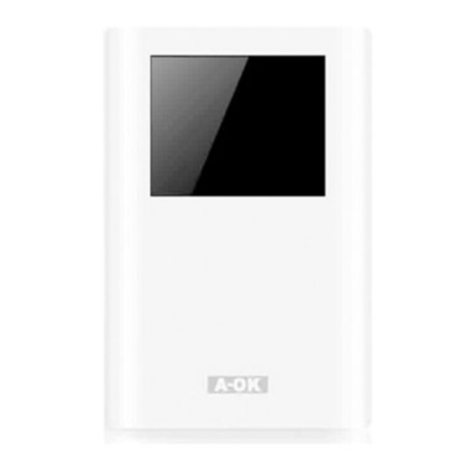
Oray
Oray OPTCOMMANDRAD8 quick start guide
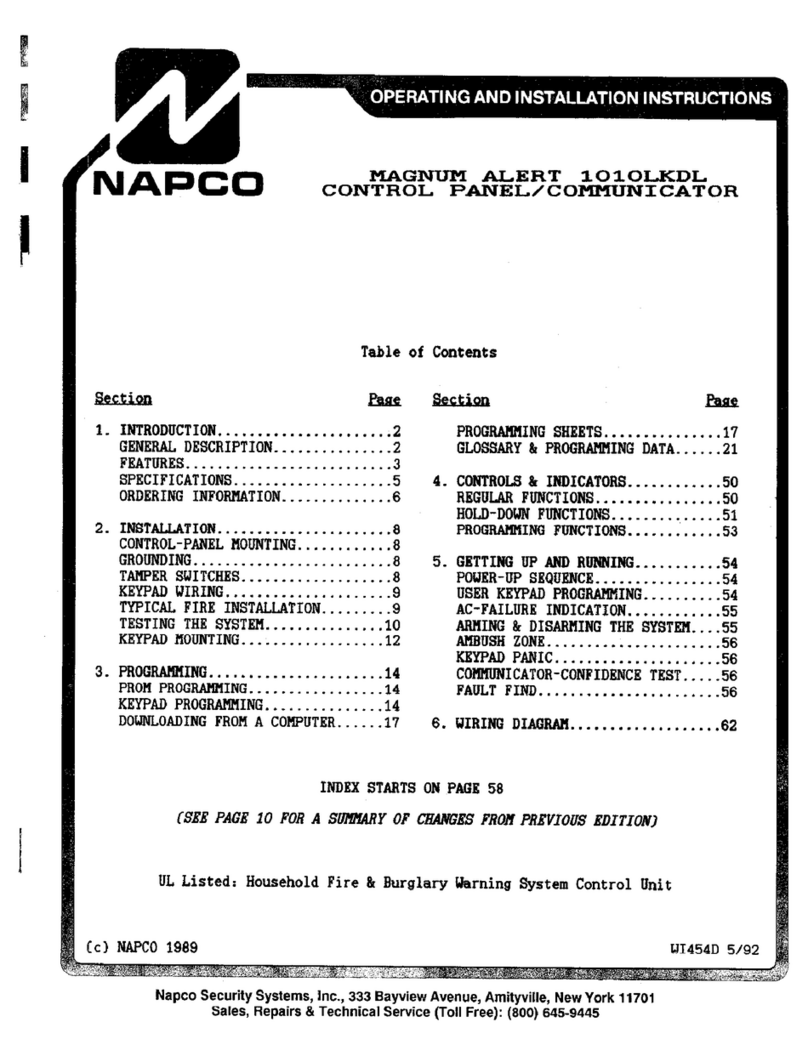
NAPCO
NAPCO Magnum Alert 1010LKDL Operating & installation instructions
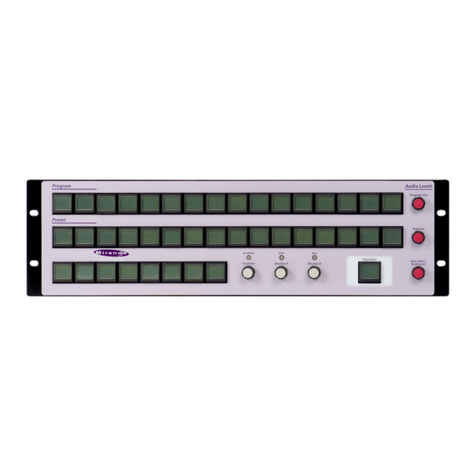
Belden
Belden Miranda iMC-Panel-100 Operator's guide
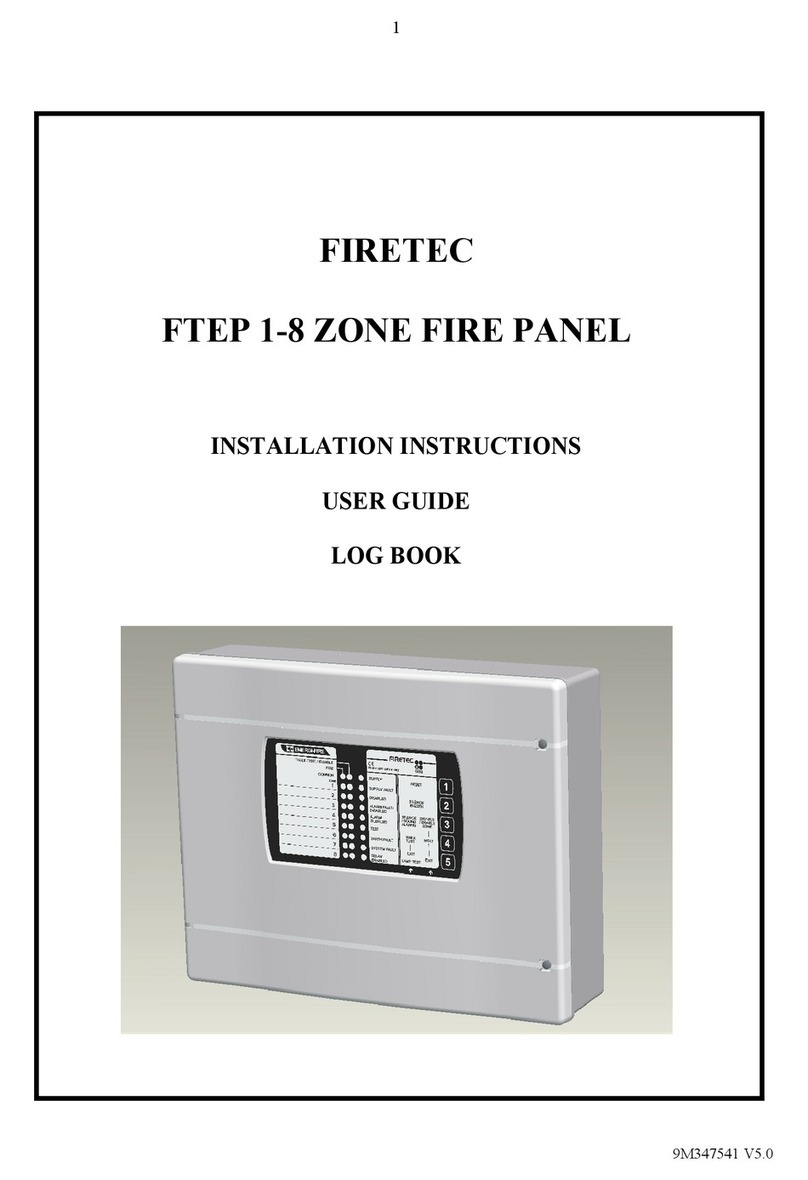
FIREtec
FIREtec FTEP SERIES Installation instructions and user guide
